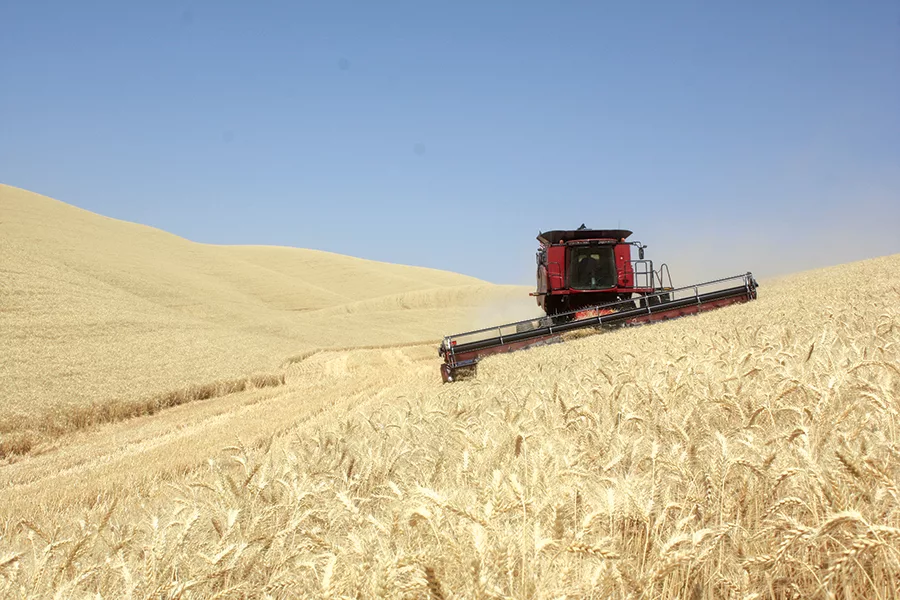
Home » Wheat production rebounds amid new challenges
Wheat production rebounds amid new challenges

June 14, 2023
After a calamitous 2021 harvest that saw the lowest total production since the 1960s, Washington wheat made a comeback the following year with a return-to-average crop. Weather conditions look poised to deliver the same for 2023.
“It’s still very early, of course. We are in the growth stage at this point, but we are feeling optimistic,” said Casey Chumrau, chief executive officer of the Washington Grain Commission, the trade arm for Washington’s wheat and barley farmers.
She said in May that crop conditions are trending toward a successful harvest.
“We had a very long cold snowy winter and a late spring. It started out a little behind schedule, but the warm weather the last few weeks has really helped with plant development. We also have received a lot of intermittent rains, which really helped.”
The 2022 total crop amounted to 144 million bushels. Contrast that to 2021, when extreme drought conditions led to dry soils and stunted plants, which resulted in a total crop of 87.1 million bushels.
“We haven’t been under 100 million bushels since 1991,” Chumrau said.
It was a hard blow to farmers after a booming 2020 bumper crop that brought in 166.2 million bushels under ideal conditions.
In 2022, regions of the Midwest experienced their share of weather-related challenges that led to poor crop production, allowing Washington to move up the rankings.
Despite being far from the Midwest breadbasket, Washington was third in the nation last year for wheat production behind North Dakota and Kansas. Montana typically outproduces Washington but had a low production year in 2022.
Wheat was Washington’s fourth highest-grossing crop in 2021 at $756.8 million, behind apples, milk and cattle, even in light of the disaster crop. In 2022, Washington wheat exports ranked No. 3 in the state and totaled $894 million.
A Washington State University IMPACT Center study on wheat found that the industry supports 9,466 jobs in the state, including the growers.
Tops for exports
Though Washington might not lead the nation – which is the world’s fifth largest wheat producer, according to the U.S. Department of Agriculture – it does offer something the landlocked Midwest doesn’t: access to ports.
Almost 100% of wheat consumed in the U.S. is grown here, with a small fraction trickling into U.S. grain elevators from farmers operating on the other side of the Canadian border.
Meanwhile, 90% of the wheat grown in Washington is shipped overseas to Asian markets, Chumrau said.
The Philippines, Japan and south Korea top the export list for Washington’s coveted soft white wheat, what everyday consumers know as pastry flour. It’s low in protein and gluten but in high demand for light and evenly-colored dumplings, noodles like ramen, crackers, cookies, pizza dough and some breads.
Wheat does not grow well in those countries, so they are import-dependent.
The trade relationship with the Philippines and South Korea began 50 to 70 years ago when they were food aid markets receiving wheat donations from the U.S., Chumrau said.
After replacing rice flours and others with wheat flour, it stuck, and since then, the Philippines has emerged as the second largest export market for all U.S. wheat across all types and classes. South Korea ranks fifth.
Chumrau said soft white wheat is almost exclusively grown in Washington, Oregon and Idaho.
“As a region, we have focused on end quality for more than four decades. We are very focused on how the wheat performs for the farmer in the field, but also at the mill and in the baking process. We’ve been very successful at breeding high quality varieties that work for both the farmer and the end user,” she said.

Challenges
Global wheat prices have come down from a year ago in part due to Ukraine’s continued ability to export some of its wheat through the Black Sea agreement between the United Nations, Turkey, Russia and Ukraine, despite the ongoing war against Russia.
Ukraine and Russia together account for roughly 30% of all global exports, Chumrau said.
What hasn’t come down is the cost of inputs, such as fuel, fertilizer, computer chips and other parts for equipment, the equipment itself and more.
Michelle Hennings, executive director at the Washington Association of Wheat Growers (WAWG), the industry’s advocacy organization, said the reference price for wheat, $5.50 per bushel, is lower than the current input cost. The reference price is what farmers are guaranteed by the federal government, so they aren’t forced to default during poor harvests.
Due to the ongoing federal debt ceiling controversy, Hennings doesn’t expect the prices to change anytime soon, though she said WAWG is advocating for more crop insurance options in current Farm Bill negotiations.
She said Midwestern states get federal margin protection to guard against unexpected decreases in operating margins. In light of increasingly unpredictable climatic and economic conditions, WAWG believes Washington growers should be eligible, too.
Adding to current high operating costs is the cap-and-invest program introduced by state lawmakers in 2021 as part of the state’s Climate Commitment Act.
An exemption for farmers and barge transport was promised, but no mechanism was created to accommodate it so growers have been paying an additional 60 cents to 70 cents at the pump with no guarantee they’ll be reimbursed.
“One of our farmers told me (the new tax) alone cost him $10,000 extra. That squeezes the farmer’s bottom line,” Hennings said.
Both Hennings and Chamrau pointed to the critical necessity of the Columbia and Snake river systems for transporting grain. According to the WAWG, wheat from 11 states travels through this river system for export, or about 60% of all U.S. wheat exports.
“Washington state is very unique because we are probably the most trade-dependent in the entire country,” Hennings said.
For perspective, one average river barge can transport 122,500 bushels of grain, versus one grain trailer, which offers a 910-bushel capacity, versus an entire 100-car train which offers a capacity of 350,000 bushels.
As Hennings said of barge transport, “It is the most cost-effective, cost-efficient and environmentally-friendly mode of transportation that we have.”
Labor
The state’s new overtime rules are incongruent with the unique nature of agriculture. WAWG has likewise been advocating for a seasonal flexibility exemption.
Though the wheat industry is more mechanized and less labor intensive than other crops, Hennings said, “Washington pays the highest hourly wage to farmworkers in the country. In addition, many farms … provide their domestic workers with additional benefits such as housing, meals and vehicles. Unfortunately, with the new overtime requirement, many farms may not be able to afford to continue providing those extra benefits.”
She said farmers are forced to make tough choices that include strategically using workers up to 48 hours to reduce overtime during harvest. This is something she’s heard workers don’t like, as they stand to lose out on wages they were previously making working more intensive hours during harvest.
All of these things threaten the ongoing existence of Washington wheat farms.
“Once they’re lost, they don’t come back,” Hennings said. “The farmer is a good steward of the land and they want to keep their land where it needs to be for the future.”
Agriculture + Viticulture
KEYWORDS june 2023





